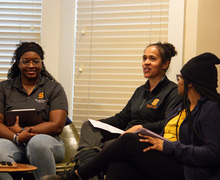SU holds 3rd annual veteran Suicide Prevention Education Talk
Christian Calabrese | Contributing Photographer
Garra Lloyd-Lester leads a panel discussion with Joule Mtanoes, Kyle Thomson and Leah Piorkowski at the 3rd annual Suicide Prevention Education Talk. The SPEd talk emphasized the importance of inviting conversations about suicide, rather than avoiding them.
Get the latest Syracuse news delivered right to your inbox.
Subscribe to our newsletter here.
Content warning: This article contains mentions of suicide.
Syracuse University’s D’Aniello Institute for Veterans & Military Families hosted Mike Waldron, the founder and executive director of the 23rd Veteran mental health program, for its annual Suicide Prevention Education Talk on Wednesday afternoon.
Waldron, a former infantryman in the United States Marine Corps, discussed his mental health struggles upon returning to civilian life. He highlighted his work with 23rd Veteran, a mental health program that uses exercise and positive psychology to mitigate PTSD, depression and suicidality in the veteran community.
IVMF first organized the SPEd Talk in 2022 to educate veterans and their families about suicide prevention and local mental health resources during Suicide Prevention Month. Now in its third year, IVMF hosted organizations specializing in mental health, suicide prevention, substance abuse recovery and veteran services for an opening resource fair before the talk with Waldron.
Since the first talk, the number of involved organizations has increased from eight to over 20 this year, said Brian Asher, the suicide prevention program manager at Syracuse Veterans Affairs. The organizers had to turn some interested groups away due to a lack of space.
“Unlike different programs, when it comes to mental health, substance abuse and resources, we really try to come together,” said Laurel Jicha, the regional services coordinator representing Conifer Park, a substance abuse treatment program. “I call all of these other (organizations) if we can’t provide services, we all collaborate and help each other out.”
Following the resource fair, attendees entered the National Veterans Resource Center’s K.G. Tan Auditorium for the talk led by Waldron and an accompanying panel discussion.
During his remarks, Waldron said he never felt settled or safe in his return to civilian life after serving in the 2003 U.S. invasion of Iraq. Over time, Waldron said he felt increasingly separated from his family and community.
After years of mistaking panic attacks for heart attacks, suffering from undiagnosed depression and other mental health challenges, Waldron attempted to take his own life, he said.
“I figured, I’m a Marine, I’m going to go out like a Marine, I’m going to exercise myself to death,” Waldron said.
Waldron’s family has a history of heart disease, so he decided that extreme exertion could trigger a heart attack and kill him, he said.
After a period of intense exercise, Waldron collapsed to the ground with a heart rate over 185 beats per minute. Instead of dying, he said he started to feel better for the first time in almost a decade. Exercise became a regular part of his life and, for the first time since being deployed, Waldron enjoyed hobbies from his old life again, he said.
Following this discovery, Waldron conducted research and worked with psychologists, exercise scientists and fellow veterans to found 23rd Veteran, a 14-week course that uses exercise and open discussions about trauma to help veterans recover.
The program is named from a report released by the U.S. Department of Veterans Affairs in 2012 which estimated that 22 veterans commit suicide every day, Waldron said. The VA reported an average of 17.5 veteran suicides per day in 2021.
23rd Veteran uses high-intensity workouts to help participants achieve a stable mental state and engages them in discussions about trauma, triggers and suicide, Waldron said.
“We need to develop a language to share how we’re feeling,” Waldron said. “It is really difficult for me to tell you how I’m doing in life based on a one to 10 scale of smiley faces if (I) have a loved one thinking about suicide.”
Waldron and the panel highlighted the need to destigmatize discussions about suicide and instead invite these conversations. Panelist and VA Mental Health Specialist Leah Piorkowski said that most suicides could be prevented simply by encouraging people to talk about their feelings and admit that they are present.
Piorkowski said that in many instances, there are only five minutes between the moment a person concludes they want to commit suicide and when they attempt to act on it. Waldron and the panel encouraged the audience to engage in difficult conversations about mental health.
“Don’t be afraid to ask the question, ‘When is the last time you thought about committing suicide?’” Waldron said. “Do your best to face the fear of being honest with yourself and those around you about your feelings. Once we’re honest with ourselves about where we are, that’s when we can start to draw the line to where we want to be.”
Published on September 19, 2024 at 12:46 am
Contact Duncan: digreen@syr.edu





